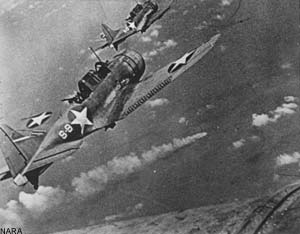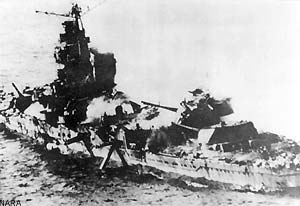
"Incontestable Mastery of the Air" - Hornet dive-bombers attack Japanese cruisers near the end of the Battle of Midway, 6 June 1942.
History:
Prewar -
1941 -
1942 -
1943 -
1944 -
1945 -
Postwar
The Ship -
All Hands -
Decorations -
Remembrance
Page 5 of 5 < Previous 1 | 2 | 3 | 4 | 5
The Japanese debacle had not yet ended. At 0342, June 5, the US submarine Tambor SS-198 startled Kurita's cruisers, which were then 90 miles west of Midway, retiring westward. In executing an emergency turn away from the sub, cruiser Mogami rammed her sistership Mikuma, buckling Mogami's bow and opening Mikuma's fuel tanks to the sea. By dawn, the two damaged cruisers, screened by two destroyers, were making 14 knots, a long slick of oil from Mikuma trailing behind them.
At dawn, June 5, Task Force 16 was steaming westward at 15 knots. In thick weather, and with too few SBDs to both scout and mount a strike, Spruance gave his airmen a well-deserved rest, while waiting for contact reports from Midway's planes. At 0700, Spruance received Tambor's report of "many unidentified ships" from earlier that morning. With a Japanese landing on Midway seemingly in the offing, Task Force 16 increased speed to 25 knots and proceeded to pass north of Midway. An hour later, a Midway-based PBY reported a damaged carrier with two battleships and three cruisers retiring to the northwest. As the morning wore on, an enemy assault on Midway seemed less likely, so Spruance turned northwest, to pursue the reported carrier.
 "Incontestable Mastery of the Air" - Hornet dive-bombers attack Japanese cruisers near the end of the Battle of Midway, 6 June 1942. |
With the trail growing cold, in Enterprise, CDR Browning proposed launching all available Dauntlesses at 1400, armed with 1000-pound bombs, to attack the enemy carrier. The airmen, catching wind of the plan, revolted. Their objection was not to the attack itself, but to the 240 mile gap estimated to lie between TF-16 and the enemy. Lugging a 1000-pound bomb, there was no hope the SBDs would have enough fuel to return to their carriers. A tense moment followed on the Flag bridge: Enterprise Air Group Commander McClusky supported by VS-6 Commander Earl Gallaher and Enterprise Captain George D. Murray, confronted Browning in front of RADM Spruance. In the end, Spruance overrode Browning, telling McClusky, "I will do what you pilots want."
The plan was modified to launch the strike at 1500, with the SBDs carrying 500-pound bombs. Once again, Hornet was not kept fully apprised of the plans, and was not quite ready to launch when the first of 32 SBDs - planes from both Enterprise and Yorktown squadrons - rumbled down the Big E's flight deck at 1512. By 1543, however, groups from both carriers were in the air and cruising northwest.
The mission itself was inconsequential. Failing to find the reported carrier, first Hornet's and then Enterprise's attack groups dove on destroyer Tanikaze. Tanikaze zigzagged furiously and fired "a large volume of small caliber and anti-aircraft fire." Not a hit was scored, a credit to the destroyer's commander, CDR Motoi Katsumi. In Enterprise's group, LT Samuel Adams of Scouting Five was shot down, with his gunner Joseph Karrol, ARM 2/c: a high price to pay for no good end.
The attack groups didn't return to Task Force 16 until after nightfall. Much has been said of Marc Mitscher's decision to "turn on the lights" late June 20, 1944, the end of the Battle of the Philippine Sea. Mitscher commanded Hornet at Midway, and he may have later been inspired by Spruance's actions on June 5, 1942. Normally, warships operated in complete darkness at night: the glow of a cigarette was enough to alert a submarine to a ship's presence. But on this night, Spruance endeared himself to his aviators by ordering TF-16 to illuminate the ships, so the Dauntlesses could land. Enterprise recovered four more SBDs than it had launched. Five from Hornet landed on the Big E, while Hornet took in one Scouting Six bomber. There was not a single accident, though many of the pilots were not qualified for night landings.
The night of June 5-6, Task Force 16 steamed west-northwest, arriving at a position 340 miles northwest of Midway by dawn. Operating close to the limits of Midway's search planes, Spruance now depended on his own scouts to find the retreating enemy. At 0510, Enterprise launched 18 SBDs - including planes from VS-6, VB-3, and the five Hornet SBDs - to search westward out to 200 miles. At 0645, a Hornet SBD reported an enemy battleship, accompanied by a cruiser and three destroyers, steaming slowly west. (Poor transmission caused the report to be received as one carrier and five destroyers.) Forty-five minutes later, a second Hornet SBD dropped a message on Enterprise's flight deck, reporting two heavy cruisers and two destroyers, in approximately the same position as the earlier report.
This time, Hornet was the first to launch, and on Saturday, June 6, her airmens' luck changed. Launching at 0757, Hornet put 25 Dauntlesses in the air, eight armed with 500-pound bombs, the rest with 1000-pounders. At 0930, Hornet Air Group commander CDR Stanhope Ring located the enemy ships, and at 0950 initiated the attack. His victims were the hapless cruisers Mogami and Mikuma.
Mogami took two bomb hits in this first attack, Mikuma several more. As Hornet recovered her strike at 1035, Enterprise prepared to launch her own: 31 Dauntless dive bombers, accompanied by the last three Torpedo Six Devastators, and an escort of 12 VF-6 Wildcats. Spruance, while convinced the torpedo planes could inflict critical damage on the enemy ships, could not accept further losses.Accordingly he instructed LT(jg) Robert Laub, who was to command VT-6, "if there is one single gun firing out there, under no circumstances are you to attack."
Enterprise's attack got underway at 1045. Led by LT Wallace Short of Yorktown's Scouting Five, the group passed over what appeared to be two cruisers and two destroyers at noon. After flying on another 30 miles in search of the non-existent battleships, Short turned back and commenced attack on the cruisers - Mogami and Mikuma - at 1215. Again Mogami absorbed two hits, but Mikuma took at least five, leaving her dead in the water, her topside utterly wrecked. Fighting Six got in the action as well, making repeated strafing runs on the destroyers, expending 4000 rounds of ammunition and "knocking off huge pieces of metal". Laub's three torpedo planes hung back and never attacked. All three returned safely to the Big E.
 The Japanese cruiser Mikuma sinking following multiple attacks by Enterprise and Hornet dive-bombers, 6 June 1942. |
As Enterprise and Hornet worked over the Japanese cruisers, I-168, the enemy submarine ordered to shell Midway early June 5 found Yorktown. By this time, a little after noon, June 6, things were looking up for the hard-hit carrier. Since the evening of June 4, Hughes DD-410 had stood by her, ready to torpedo the carrier should she be at risk of capture by the Japanese. The morning of June 5, Hughes reported the carrier appeared salvageable, and by 1426, Yorktown was under tow by the minesweeper Vireo AM-52. As the day wore on, a salvage party, led by Yorktown's Captain Buckmaster, arrived, boarded the ship, and began stripping her of equipment to reduce her list. Additional destroyers, including Hammann DD-412 arrived to cover her withdrawal.
By 1237, June 6, I-168 had slipped to within 500 yards of the carrier, which made only three knots in tow by the straining Vireo. Poor acoustical conditions impeded the sonar equipment aboard the destroyers, enabling I-168 to fire four torpedoes at about 1334. One torpedo missed, one caught Hammann amidships and broke her in half, while the last two ripped open Yorktown's battered port side. The damage was more than the salvage crew could overcome, and at 0458, June 7, Yorktown - sistership of Enterprise and Hornet - rolled over and settled beneath the waves.
Even as I-168 delivered the fatal blow to Yorktown, Hornet again struck at the wrecked enemy cruisers, launching 24 SBDs armed with 1000-lb bombs which attacked at 1445. Shortly afterwards, Enterprise launched her last mission of the battle, two SBDs equipped with cameras, to photograph the enemy ships. Mogami managed to escape, eventually reaching Truk, and out of action for over a year. The SBDs found Mikuma settling quickly: the photos they took rank among the best known of the Pacific War.
Shortly after the final attacks on Mikuma, Spruance concluded it would be best to break off pursuit of the enemy, as he would soon be in range of enemy planes based on Wake Island. At 1900, Task Force 16, its ships full of exhausted but victorious aviators and sailors, turned east, first to rendezvous with oilers, and then to proceed southeast to Pearl Harbor, arriving late June 13.
For a number of reasons, the decisive role that Enterprise and the US Navy played at Midway remained under-appreciated for some time. Stories of the Army Air Force's exploits during the battle reached the news media first. Despite the fact that not a single hit was scored by the AAF's bombers, initially they received much of the credit for the destruction of Nagumo's carriers. Only time and the lifting of the veils of secrecy and censorship would reveal the facts.
The Army and Marine planes based at Midway deserve full credit for their attacks on the enemy carriers, and the disruption they caused. Yet at twenty minutes past ten, the morning of June 4, 1942, dive bombers from Enterprise and Yorktown found four undamaged enemy carriers, preparing to launch a powerful attack against the US fleet. Six minutes later, three of those carriers were infernos. Enterprise destroyed two enemy carriers in those six minutes, Yorktown one. Aviators from both carriers, flying from Enterprise, destroyed the fourth carrier later that same day.
In no other battle was Enterprise so instrumental in forging decisive victory as she was at Midway. In no other battle did Enterprise - or arguably any other US Navy ship - deliver in a single blow such a stunning reversal to Japanese fortune.
Midway was a brilliant, inspired and fortuitous victory for the United States. In a single stroke, the US Navy, assisted by the Marines and the Army Air Force, essentially "leveled the playing field" in the Pacific. But the battle was not - as it is frequently referred to - the turning point of the war in the Pacific. The moment when the tide of fortunes would turn irreversibly in the Allies favor was still many months away. The decision would be reached in the South Pacific, on New Guinea, and on a then-unfamiliar island at the eastern end of the Solomon Islands, named Guadalcanal.
Beginning in August 1942, six months of brutal land and naval battles would bloody Guadalcanal and the surrounding seas. In those six months, no other US carrier would be more heavily engaged than Enterprise.
Image Library -
Action Reports and Logs -
News Stories
Message Boards -
Bookstore -
Enterprise CV-6 Association
Copyright © 1998-2006 Joel Shepherd ([email protected])
Sources and Credits